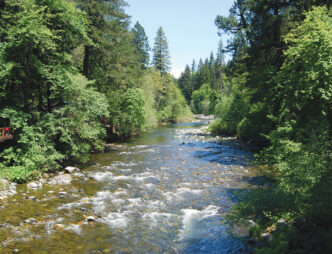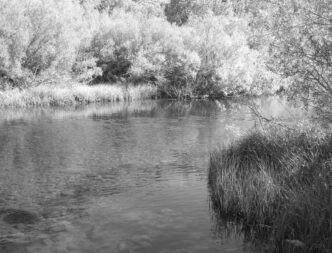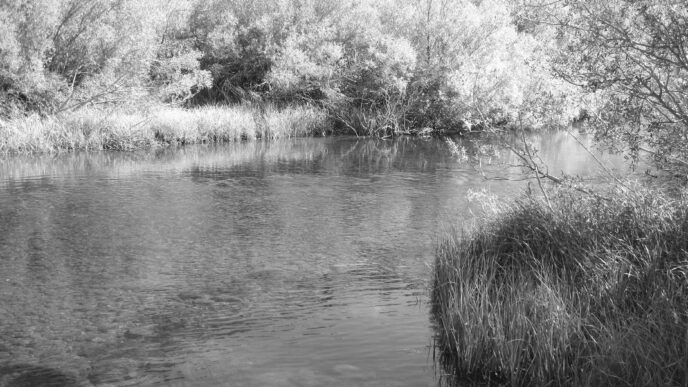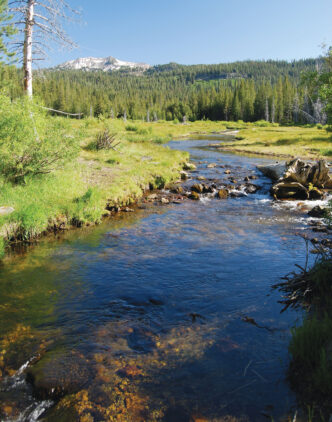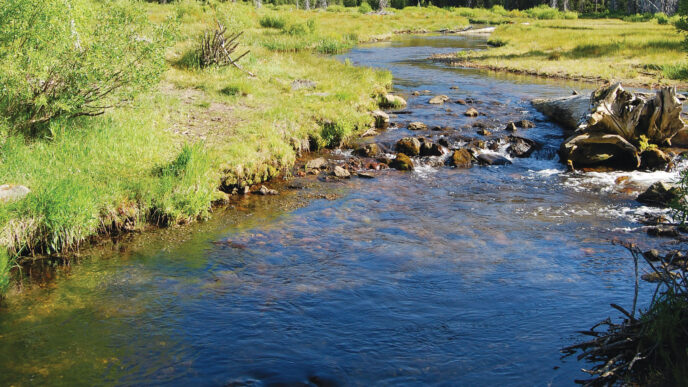The Upper Sacramento River is properly touted as one of America’s premier wild-trout streams. It begins with releases from Siskiyou Dam that are augmented by many small tributaries, waterfalls, and springs before it empties into Lake Shasta — a run of almost 40 miles. (By contrast, the renowned Hot Creek near Mammoth Lakes has one mile of public water.) It possesses many sterling features: abundant wild rainbows, with an occasional brown, including many above 15 inches on up to 25 inches; pure, cold water; prolific insect hatches and other foods on which trout gorge; and proximity to where you can park a car. The canyon in which it flows is splendorous in its beauty and biological richness.
The fuzzy element in this otherwise captivating picture is the fishing. There are times when it seems as if no trout occupy the crystal-clear water. Other (far fewer) times, they magically appear out of nowhere, and the catch rate is superior. And despite the much-publicized ease of access, getting to and fishing prime water can be anything but easy.
I asked a longtime Northern California angler about places to fish on the upper Sacramento. Here is his succinct response.
My general observations are: 1) Walking miles on the railroad tracks to get to better fishing does not lead to better fishing. It only wears you out! I’ve done as well close to where I park the truck as I have a mile or more away. 2) If you see a good-looking piece of water from the tracks, don’t go busting through the brush trying to get there. Others will have seen the same water long before you did, and there will be a trail somewhere. If not, you may eventually get down to the water, but you with your torn waders might never get back out! And 3) It’s hard to catch a fish over 14 inches. Maybe it’s because I stick with dries too much, or maybe they are early feeders and I arrive late!
On the other hand, in May of this year, I spoke to an angler who lives in Dunsmuir and who had fished 280 days in 2013, mainly on this river. He reported that the previous day, he had hooked three rainbows on the surface within 30 minutes, each approaching 25 inches, using a big Stimulator fly to imitate a Golden Stonefly. He was hoping for similar action that evening, but each time out is different, he said. How true.The same day, a friend and I fished a pool that usually provides good angling late in the afternoon. Not only did we have no strikes, we didn’t see a single rise. You can’t know in advance which version of the upper Sac you’ll be fishing on any given day. What further complicates the angling on this blue-ribbon trout stream is the diversity that it offers the fly fisher with regard to types of water, access, and angling tactics. Here is a survey of the many angling opportunities that the river presents.
River Features, Access, Tactics
In its long run to Lake Shasta, the upper Sacramento, a classic freestone river, presents just about every kind of water imaginable — long, deep pools, riffles and cascades, plunge pools and pocket water, extended runs and glides, flats and tailouts. Some of the most productive river locations are those with a number of these features in a single stretch, thus either allowing or requiring many different ways to hook a trout. From Lake Siskiyou to Shasta Lake, the elevation drops 2,000 feet. The steepest drop — about 90 feet per mile — is from Box Canyon to Dunsmuir. Below Dunsmuir and on to Shasta Lake, the drop is 40 feet per mile. Consequently, the upper river is smaller and swifter, presenting a multitude of short pools, rapids, and pocket water. In contrast, the lower river is larger and flatter, with long pools and runs, interspersed with fewer gushes of white water. Water temperatures best suited to trout feeding, from 58 degrees to 62 degrees, will be found in the lower stretches during the colder months and in the upper parts during the warmer months. But trout fishing is anything but predictable. For instance, the river right above Shasta Lake, at Dog Creek and Delta, may see migrating fish coming up from the lake in the dead of summer to seek colder water. This lower river is also apt to hold smallmouth bass, largemouth bass, and spotted bass — all migrants from Shasta Lake.
Seasons, of course, make a difference. Winter and spring might see high flows that greatly limit or preclude fishing. When conditions allow, however, winter fly fishing can produce hookups with the biggest fish. Summer and early fall fly fishing typically requires delicate presentations in clear, low water to very cautious trout, which is why the crack of dawn and fading dusk are prime times for hookups. Fortunately, even when the river is at its lowest, for instance, during this year of a severe drought, springs such as Mossbrae Falls and Shasta Springs, among many other smaller ones, ensure cold flows.
While the river flows right alongside Interstate 5, and the railroad track paralleling the river provides a convenient pathway along it, one must still find a place to get to the water and once there be able to fish it. Steep hillsides, often to support the rail track, and heavily vegetated shorelines, particularly with Himalayan blackberry and poison oak bushes, are pervasive. (A close friend once lost his footing and tumbled into a thicket of blackberry bushes. He says that if a companion hadn’t been there to help extricate him, he might still be entangled amid the thorns. And I broke my rod one time scrambling up a gravel bank, only to slip and crash my rod down on a rock.) So spotting a promising run on the river is only the start; one must then find a pathway to it, which, thanks to the anglers who came before you, is usually available, someplace.
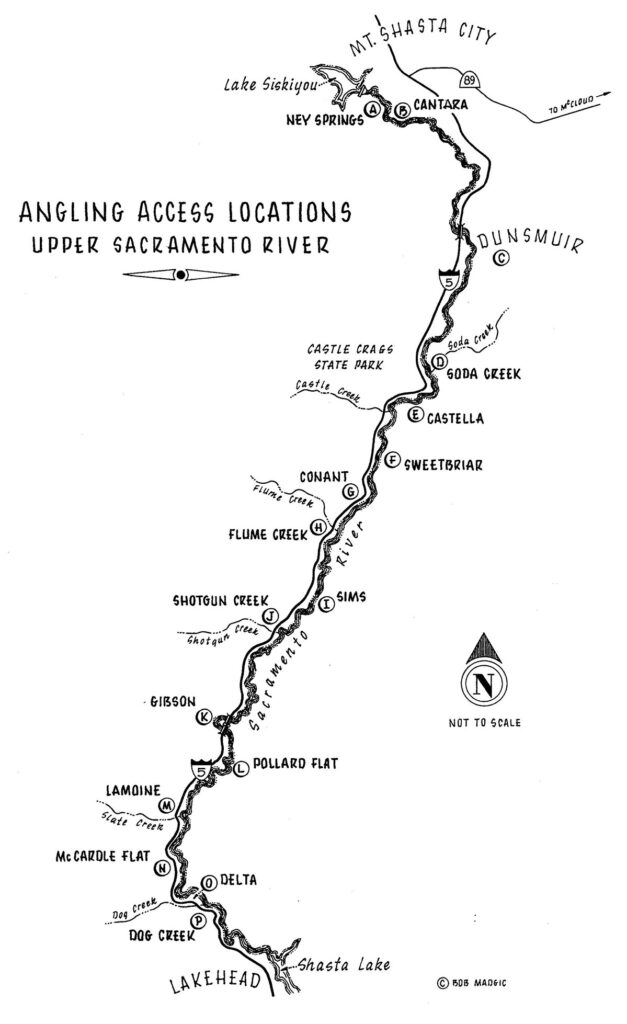
Then, when you reach the river, polished boulders of all sizes line the shoreline; those in the water are often highly slippery. Worse is riprap. In many places, impenetrable bushes, canyon walls, or deep water prevent any passage. Too frequently, it seems, the more open and navigable shoreline is on the other side, requiring a crossing, if possible.
And often, the best-looking run flows against the far bank, with a current between you and it. This requires the ability to cast to that run and have the fly drift naturally long enough before the current grabs the line. An effective roll cast is a good skill to possess, given the riverside foliage. So it takes a lot of work to fish this river. And the persnickety trout are not going to make it any easier.
The variety of the types of water available requires a full array of tactics. The classic approach is that of the legendary Ted Fay. He tied heavily weighted flies resembling organisms being swept down the river: black and brown “Bomber” flies imitating caddis larvae, caterpillars, and yellow jackets, among others. He placed two flies about 12 inches apart. Then, using a staff, he waded aggressively out to where rainbows hold: in gushing water just upstream or below rocks where water tumbles and swirls — pocket water. (This tactic is most effective when water levels drop, and trout seek well-oxygenated water.) He sunk his two weighted flies on a short line in the churning water, right where a trout might lie, waiting for food. Reportedly, Fay once caught 76 fish in two hours; he also was said to have hooked two fish simultaneously on each of five casts, for a total of 10 fish. If this is true, it has to be one of the most remarkable fly-fishing achievements ever.
Ted Fay’s mastery of the upper Sac helps explain why longtime (now deceased) outdoor writer Larry Green referred to it as a “trout factory.” Some reports showed the river holding an astounding 9,000 fish per mile, with many in the five-to-eight-pound class. Augmenting what was already a thriving wild-trout fishery, however, were the tons of hatchery trout that were dumped into the river. Then, after the infamous Cantara Loop spill of metam sodium in 1991 that almost wiped out the entire fishery, the wild-trout movement gathered momentum and soon took charge of the upper Sac.
Fortunately, the river recovered from the toxic spill, with wild trout from the tributaries repopulating the river, accompanied by new regulations to make this basically a wild-trout river. There would be no more planted fish, other than around Dunsmuir. But a self-sustaining wild-trout population, combined with angling pressure, means that an angler has to work much harder for hookups than Ted Fay did. Today’s river probably holds 4,000 to 5,000 trout per mile.
Beyond Fay’s approach, which is still deadly, the full range of fly-fishing tactics can be effective, depending on the season and the water flows. Each has its staunch proponents. Some sink a heavily weighted two-fly or even three-fly rig in a gushing flow, a slight variation of the Ted Fay method. Some drift one, two, or three flies (either with an indicator or not) in the flatter, rippling water. Some sink small nymphs, size 14 to 18, under an indicator in the deep pools. (One expert fly fisher swears by this technique, saying that he has learned to go with smaller nymphs to catch the biggest fish in the deepest pools.) Others run streamers and other larger patterns, such as Woolly Buggers, Rubberlegs Nymphs, or Woolly Worms, through the runs. Some cast dry patterns, especially during hatches, which on this river are frequent. Some fish terrestrial patterns, such as the Ted Fay assortment or grasshopper, beetle, or ant imitations, either down in the depths or on the surface, depending on what they are trying to imitate. And when nothing is producing, some fish attractor patterns, such as the Royal Coachman or Royal Wulff.
To be ready to employ different tactics, a highly effective strategy is to have two rods ready with different setups. This is easier said than done, however, when traversing shorelines and wading.

Regarding fly choice, the upper Sac is renowned for its thick Golden Stonefly hatches in the spring, and October Caddis hatches in the fall. But just about every fly pattern imaginable has been recommended by someone at one time or another. The best way to know the current hatches and most effective fly patterns is to visit the Web sites of the fly shops and guides who target this river. (See “If You Go . . .” at end of this article.)
In reflecting on my many trips to this demanding river, I’ve realized that the single most important factor for fishing success has been the time of day when I fished, or even more so, when I have not fished. Midday, with a bright, sunny sky and crystal-clear water, almost guarantees getting skunked. Whenever I was there as darkness approached, or at the break of dawn (once, as I recall), I found eager trout. In the cooler months on through the winter, midday or midafternoon was apt to be the best time. Weather also matters. For instance, low clouds can spur insect hatches and encourage surface-feeding trout.
One thus has to be in full harmony with this river’s many rhythms and a trout’s vagaries and moods to experience fully what this rich river can provide. Either that or fish 280 days a year, thereby ensuring you are there during those few remarkable times when large rainbows are taking big Stimulators on the surface.
Angling Access Locations
With few exceptions, each of the following access locations indicated by letters on the accompanying map is directly off Interstate 5 and clearly marked with signs. Fishing locations on the upper Sacramento are rated as: ★★★★ excellent, ★★★ good, ★★ fair, and ★ poor. The ratings are based on a loose combination of ease of access; expanse of fishable water to accommodate several anglers, if need be; quality of the water for holding trout; wadeability; and the potential for fishing success. These descriptions are based on medium to low-water flows, when an angler can comfortably wade much of the river.
Regulations for the upper Sacramento are divided into three zones.
Zone 1. Box Canyon to the bridge at Scarlett Way (the upper end of Dunsmuir). No trout can be kept; artificial lures with barbless hooks only.
Zone 2. Scarlett Way to Sweetbriar Bridge. Five trout can be kept; there are no restrictions on methods from the last Saturday in April through November 15.
Zone 3. Sweetbriar Bridge to Shasta Lake. Two trout can be kept; artificial lures with barbless hooks only, from the last Saturday in April through November 15.
No trout can be kept in any zone from November 16 through the last Friday in April.
A. Ney Springs ★★
To reach this part of river, just below Box Canyon, you cross the dam heading west at Lake Siskiyou, go up the road a short distance, turn left on Castle Lake Road, and then quickly left onto Ney Springs Road. A windy gravel road takes you down to the river, where there is a small picnic area and a couple of trails to the water. Upriver are runs, riffles, and pocket water, but wading is limited to a small stretch. Downriver is a very long pool, offering dry-fly and nymph fishing with extended drifts possible. Below the pool are stretches of broken water and runs in a small gorge that require caution in wading and traversing. It’s about a quarter of a mile to Cantara.
B. Cantara ★★★★
This is an easily accessible part of the upper river where the train cars toppled off the tracks on the infamous Cantara Loop in 1991. There is a lot of river, with different types of water here, including pocket water and pools throughout, but with tricky walking and wading. This popular location is reached from Old Stage Road, south of Mt. Shasta, via a turn on to Cantara Street and then a mile on a gravel road to the parking area at Cantara. You can fish upstream back to Ney Springs or downstream a few miles to Mossbrae Falls.
C. Dunsmuir ★★★
For years, whenever anyone asked fabled fishing guide and successor to Ted Fay, Joe Kimsey, where the best place is to fish, invariably, his answer was, “Right here in town.” And this was where he usually took his clients. So the fishing within the Dunsmuir city limits can be very good, although much of what is being caught these days are hatchery plants, with a fivefish limit. Nonetheless, the mix of planted and wild trout can provide action throughout this area.
There are many places to access the river here, too many for detailed descriptions. For more exact information, it’s best to check in at the Ted Fay Fly Shop or with guides. Or get the Stream Time Upper Sacramento River map. Since little driving is required, the fly fisher can fish several locations in one outing. You should know the following:
- At Prospect Avenue, you have to cross the river to fish or proceed upriver to Mossbrae Falls. So fishing and trekking upriver is available here in low flows only.
- A parking area at the bridge at Scarlett Way used to be available for hikers to the spectacular Mossbrae Falls. It is now closed. A trail from Dunsmuir to the falls is being built, but completion is contingent on the St. Germain Society granting an easement over its property at Shasta Springs.
- Dunsmuir City Park is an attractive and user-friendly place where you can catch mostly planted fish, with some real lunkers tossed into the mix.
- Other Dunsmuir locations include the I-5 bridge, River Avenue, Ball Park Road, the South First Street bridge, Financial Street, Scherrer Avenue, River Avenue, and Katherine Street.
D. Soda Creek ★★★
A bridge crosses the river at this popular spot. The wader willing to walk a ways above or below the bridge will find pocket water and runs to fish. This area is still within Zone 1, so five trout can be kept. Driving past the bridge can take you on a winding road all the way to Castella. Although the road traverses a steep hillside, the angler can perhaps drop down to a place or two on the river along this stretch.

E. Castella ★★★
This, too, is a user-friendly and very accessible location, mostly due to the presence of a U.S. Forest Service picnic and camping spot on the east side of river with a trail alongside. You can walk this trail and hit whatever part of the river looks most promising. There is pocket water here for nymphing, with wading required to reach the most promising lies.
F. Sweetbriar ★★★
Many vacation cabins are located here, but they do not preclude good fishing prospects. You should park on the west side of the tracks before visiting the river. The fly fisher can work upstream from the bridge here and hit some great water. Downstream is wadeable, too, with a long run of unbroken water.
G. Conant ★★★★
This is actually two locations, with lots of fishable water. Parking for what is called “upper Conant” is close to where you exit the freeway. There is a long stretch of river with bushy shorelines requiring extensive wading to fish. “Lower Conant” is reachable by a drive back under the freeway to the very end of the road, where there is parking. After crossing the railroad tracks, you then have to find a pathway to a long run of rippling water. Ambitious wading, or walking the railroad tracks, is required to fish prime water throughout this long stretch.
H. Flume Creek ★★★
This is a splendid part of the river, but access is not as convenient as at other locations. There are two places to park and hit the river. One is right off the freeway before the Flume Creek exit heading north on I-5. There is a locked gate here and a road leading down to the railroad tracks, where you still have to locate a pathway down to the river. Once there, however, the beauty and fishability of the river are magnificent, with long, varied stretches, the shorelines dabbled with Indian rhubarb. The second access is at the Flume Creek exit, where minimal parking is available. To reach the river requires a pathless descent. Downstream about a quarter of a mile from the mouth of Flume Creek, the river flows through a constriction between large rocks, with more fishable water situated below.
I. Sims Flat ★★★★
A U.S. Forest Service campground is here, reached by crossing a historic bridge that was the first completed project of the Civilian Conservation Corps in the 1930s. Sims Flat is a popular place for campers and anglers and is where many rafters put in. This section of river presents flatter water than most other places. There is an abundance of very fishable water upstream and especially downstream, where you can get away from other anglers. From Sims downriver to where Shotgun Creek enters is about two miles, all very fishable and productive water.
J. Shotgun Creek. ★★★
A dirt road that is easy to miss off I-5 south of Shotgun Creek will take you down to river. Continuing on the road will bring you to near where Shotgun Creek enters. You will find deep pools in this part of the river and a rocky shoreline.
K. Gipson ★★
A long, winding road leads to a broad parking area where workers on the rail line park. The river sits below a bank of riprap and bushes, so not only access to the water, but wading is limited due to deep water. As usual, one can walk the rail tracks to find places to fish.
L. Pollard Flat ★★★★
This is a popular location due to ease of access on a paved road leading to a small picnic area with restrooms. The river here is quite diverse, with some great-looking pools not all easily fished. Some sit below steep rock walls; others have dense bushes that hinder access and casting. And so it goes. Yet there are many places where the river is very open. To fish farther away from where you park, you can walk on a road upriver to access different kinds of water. There are some very productive pools downriver, which can be reached only by walking across the railroad bridge here, which involves the prospect of encountering a train.
M. LaMoine ★★
There are long stretches of slow water here, largely encased by Indian rhubarb bushes. This lower part is also where catching bass begins to be a possibility. Although the river is readily accessible, the surroundings and types of water are less attractive for the fly fisher than at other locations. Still, there are some deep pools and longer runs that can be productively probed with a fly.
N. McCardle Flat ★★★★
This lower part of the upper river offers several stretches of fishable water that vary in character and tactical approach. Take the Vollmers exit from I-5 and then follow the sign to McCardle Flat on what becomes a dirt road leading down to the tracks, where it branches off to the left and right. The road to the left leads to ample parking and good access, either on foot or by continued driving, to an extended stretch of river. The narrower road to the right at the junction stays close to the rail tracks and ends in about a hundred yards. There is a big, very fishable pool there; it is popular with swimmers and vagrants in the summer. One can also wade both above and below it to reach some riffle stretches.

O. Delta ★★
This location is accessed by taking the Vollmers exit and then heading east. It offers decent fishing with sufficiently varied waters for different tactics. Near where you park, the river is more open on the other side, thus requiring a crossing. But one can also trek upstream and downstream to find productive angling. Some anglers head here when they believe big trout from Shasta Lake are on their way upriver. It’s also a good place to target bass. The spring is probably the best time to fish here, when the water temperatures are lower than during the dog days of summer.
P. Dog Creek ★★
To reach Dog Creek, take the Vollmers exit and then go west to Fenders Ferry Road, which crosses pretty Dog Creek. There is a long, slow run here, with easy water access, plus riffles above and below. So combined with Delta, there is lots of water to fish in this lower part of the upper river. One added reason to come here is to see the beautiful and historic bridge over Dog Creek, said to be one of the most artistic and spectacular bridges ever built in California. When built in 1927, it had one of the longest arch spans in the state. It stopped being used in 1974. An advantage of fishing these lower sections of river — McCardle, Delta, and Dog Creek — is their proximity to Redding, although this also brings in more nonanglers, as well.
If You
For more detailed information fly-fishing information, see the Upper Sacramento River Fishing Access Guide, a Stream Time publication.
Before heading up to the upper Sac, it’s best to either call ahead or check Web sites for current water conditions, hatches, flies to use, and so forth. Bob Grace at the Ted Fay Fly Shop in Dunsmuir can be reached at (530) 235-2969. Several Web sites and blogs offer current information on fishing prospects, including Bob Grace’s Guide Notes (http://www.tedfay.com/guidenotes.html), Craig Nielsen’s Shasta Trout (http://www.shastatrout.com/fishing-reports), Tom Chandler’s Trout Underground (http://troutunderground.com), Rick Cox’s guide service (http://www.mccloudflyfishing.com/fishingreports.html), and Steve Bertrand’s guide service (http://flyguide.wordpress.com). A call or stop at The Fly Shop in Redding (530222-3555) will also give you all the information you need (http://www.theflyshop.com).
Overnight accommodations are readily available in Redding, Dunsmuir, and Mt. Shasta. Redding has too many choices to list here, many of the top chains being right along Interstate 5. Lodging in Dunsmuir includes the Cave Springs Motel, the Cedar Lodge Motel, and the Railroad Park Resort. Mt. Shasta also has a slew of places for overnight stays, including the Mt. Shasta Resort, the Best Western Tree House, the Strawberry Valley Inn Bed and Breakfast, and the Mt. Shasta Ranch Bed and Breakfast.
—Bob Madgic



